Last I week I posted about the Itanium 2 9000 Series being launched with hardware virtualization support (what was formerly known as Silvervale). I also mentioned that neither Windows 2003, Virtual Server, nor Longhorn will support virtualization on this platform. That much is true from Microsoft’s perspective, but HP is indeed planning to support Windows 2003 Server through its Virtual Server Environment.
The Virtual Server Environment has been available for a while, and also has an enterprise-class management tool in the HP Integrity Essentials Virtualization Manager. This is currently available for HP-UX, but will also be available for Linux and Windows in the near future. The Virtualization Manager has some interesting features, and is also integrated with HP’s Serviceguard product. From last month’s press release:
... For example, customers can use the capability to automatically allocate additional server capacity to financial applications during the month-end close.
For customers that are concerned about the availability of their mission-critical UNIX® environments when they consolidate using virtualization, HP has further integrated HP Serviceguard for HP-UX 11i with HP Integrity Virtual Machines. Available now with the latest release of HP Serviceguard, this functionality helps guard against failure by automatically moving the virtual machines between servers in a VSE. HP Integrity Virtual Machines also now enables easy manual migration of virtual machines, accelerating application qualification and deployment....
Keep in mind that HP also offer Node Partitions (nPars) and Virtual Partitions (vPars) options on the high-end Integrity and 9000 lines of servers, with Instant Capacity on Demand (iCOD) capabilities. Depending on your requirements, these may be even better options than virtual machines pure virtual machines.
Usually when you install a beta OS with a beta productivity app, things can go wrong, or at least that's what you expect. That was exactly what I thought when I tried to install the latest beta of Virtual Server on Longhorn Beta. I got an error telling me that I did not have IIS installed and could therefore could not install Virtual Server. After reading the an old
blog entry from the
Virtual PC Guy's weblog (this guy gets paid to test old games ;), the soulution is simply to install ALL the IIS 6 Management Compatibility components and you are good to go:

...welll...as far as installing goes. I am now having problems with other things for which I hope to post the solution pretty soon...ah the beauty of beta software!!
This is a post from several months ago that I made on the 64–bit Advantage blog. Since now we’re working with virtualization (at the time it was only an interest of mine), I think it is worth it to re-post it here:
I wanted to make a brief mention of the Virtualization Technology that is being introduced in the latest generation of Intel CPUs (known as VT-x). This technology was formerly known as "Vanderpool", and it is already available on some Pentium 4, Pentium D, Xeon and Core Duo CPUs. Later this year it will also be available on the next generation Itanium CPUs, using a technology known as "Silvervale".
I was talking with a coworker the other day about this technology, and our main question was "What is it exactly that it does? What advantage would it have over traditional software virtualization?" Well, to answer these two questions:
On a virtualization environment, there's the Virtual Machine Monitor (VMM), which handles the processor and physical resources of the machine, and the Guest Software, which operate inside a Virtual Machine handled by the VMM. VT-x introduces 10 new intructions to the architecture for facilitating the tasks of the VMM. Some of them, such as VMLAUNCH and VMRESUME, allow the VMM to start/enter running VMs, or VMON/VMOFF, turns the Virtualization functionality on and off.
The main reasons for using VT-x over software virtualization are speed and reliability. With hardware support, you are pretty much creating the equivalent of a hardware partition for the Guest Software, which improves both the performance and the robustness of the VM - and this is vital for consolidated server environments, one of the areas where VT-x is expected to be heavily used.
Now, one thing- why mention Intel's VT-x on this site? Well, one of the strenghts of 64-bit computing is that with more resources available on a single box, it is easier to to consolidate servers. With the new support for virtualization on the CPUs, you can use Virtual Machines for consolidation, so each software server has its own isolated environment without sacrificing performance.
More information here.
After reading Jose's blog
entry, I immediately had some questions about virtualization on the new
dual-core Itanium architecture. First and foremost, which software vendor
out there has a Virtualization solution that supports the Itanium? As far
as I know, the roadmap for Virtual Server 2005 R2 SP1 does not include support
for the Itanium. Longhorn's roadmap does not include any foreseen support
for the hypervisor on the Itanium either, so no luck in there as well.
Secondly, if some company indeed supported VT on the Itanium and allowed you to
say, run Windows XP 32-bit on a virtual machine, would that be faster
than running the a 32-bit application directly on Windows Server for the
Itanium? Also, how would the WoW64’s performance (which IMHO is the
Itanium's Achilles’ heel) be affected by the fact that there is VT support?
These are many, many questions for which I have no answer
for and hopefully will be addressed soon enough.
After several years of delays, the Dual-core Itanium 2, formerly known as Montecito, was unveiled by Intel. According to the press release:
They double the performance and lower energy requirements, improving performance per watt by 2.5 times compared to existing, single-core versions.
The Dual-Core Intel® Itanium® 2 processor 9000 series delivers performance at a system scale unmatched by competing RISC architectures. It set world record results in several key server benchmarks including a score of 4230 SPEC_int_rate_base_20001, nearly triple the previous record.
The CPU incorporates virtualization features, similar to the ones found on current-generation Intel x86 CPUs. My understanding is that neither Windows 2003 Server nor Viridian will support VT on the Itaniums, but my guess is that other vendors will, especially with the enhanced CPU horsepower and memory capability of this boxes.
Also, according to the press release, the Itanium Solutions Alliance is working on new system and applications that will leverage the power of this new CPU. We've worked with the ISA in the past, for the Developer Days events, in which we showed ISV how to port and optimize their applications for 64-bit Windows.
Link to the press release: New Dual-Core Intel® Itanium® 2 Processor Doubles Performance, Reduces Power Consumption
One of the nicest features of using Dynamic VHDs on Virtual Server 2005 is that they grow as needed, so system administrators can optimize the disk space usage between several VMs. Dynamic VHDs grow automatically, but they don’t shrink automatically. In order to shrink them, you need to run several tools both inside and outside of the virtual machine.
Recently, I installed Windows Vista Beta 2 on a virtual machine on Virtual Server. Right after the installation, this are the disk usage stats:

Inside the virtual machine, however, the total disk space usage was smaller:
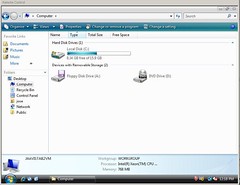
In order to compact the VHD image to only use the ~9GB allocated, we need to follow this procedure:
The first step is to defragment the VHD you are going to compact. You do this from within the Virtual Machine. Once the defragmentation is completed, you need to run Virtual Server’s Precompactor. To do this, mount the image on the virtual machine from the Virtual Server console:

The precompactor will then execute and leave the VHD ready for compaction:


If you are running the precompactor under Vista, remember to do a “Run as administrator”. Otherwise it won’t work.
This process may (will) take a long time, so be patient.
Once it completes, you need to shut down the virtual machine, and compact the VHD from the Virtual Server web console. This can be done from the option Virtual Disks->Inspect, then select the correct VHD on the Known virtual hard disks drop-down box, and click on the Inspect button. Then select the link to Compact Virtual Hard Disk:

You need to click on the Compact button on the next screen, and the process will then start. This will also take a while, but once it finished, you will reclaim all the hard drive space from your VHD file! 
Yes, it is sad but true. You cannot install the Virtual Server 2005 Migration Toolkit on an x64 server:
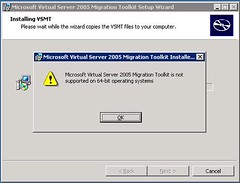
What this means is that you need to have an intermediate 32–bit Windows 2003 installation running Virtual Server in order to convert a physical server to a virtual one. Hopefully x64 server will be soported in the near future.
Here is a post that talks about this: ADS 1.1 and VSMT on 64-bit hosts
Virtual PC 2004 Service Pack 1 is now offered as a free download. From the webpage:
Whether Microsoft virtualization technology is an important component of your existing infrastructure or you're just a Virtual PC enthusiast, you can now download Virtual PC 2004 Service Pack 1 absolutely free. Microsoft is also offering the free download of Virtual PC 2007, with support for Windows Vista in 2007.
Hopefully this will further increase the adoption of virtualization technology. I can’t wait for VPC2007 for it to support for hardware virtualization, like Virtual Server 2005.
Most you I guess have heard about Sysprep, Microsoft’s System Preparation Tool. This tool removes certain information from a system, including the Security Identifier, IP address, computer name, etc. This is recommended when you are cloning a machine, and, by removing this information, you also remove any potential conflicts when starting up the cloned image for the first time.
When working with Virtual Machines, Sysprep is a real timesaver. You can, on a virtual machine, install several configurations of servers (Win2003EE/SQLServer2005, Win2003EE/IIS6.0, etc), sysprep the images, and then have these pre-configured images ready to deploy to a Virtual Server 2005 installation when needed, by just copying the appropriate VHD file over and associating it with a new VM.
In order to run Sysprep, you first need to install it. You can get a hold of Sysprep in two ways: it is on the \Support\Tools\Deploy.cab file on the Windows Server installation media, or you can download it from here. Once you get a hold of the Deploy.cab file, you should extract the contents to a directory on your HD, for example c:\Deploy.
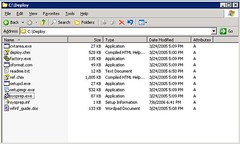
This directory contains several useful tools, and you should definitely read the deploy.chm file for instructions and details on the process. There are two files that are of particular importance to the process: sysprep.exe and setupmgr.exe.
For sysprep to work completely automated, it requires an answer file, called sysprep.inf. This answer file contains the “answers” to all the questions asked by the Windows installer during the setup process. The answer file can be created manually with any text editor, but fortunately there is a nice wizard-like tool that can help you generate this file. This tool is the setupmgr.exe program:
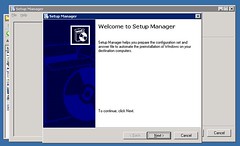
This program allows you to generate the sysprep.inf file by presenting you the options and letting you enter the default answer. In order to fully automate an installation, follow these steps on the Setup Manager:
- Click Next on the Welcome screen
- Select “Create new” and click “Next”
- Select “Sysprep setup” and click “Next”:
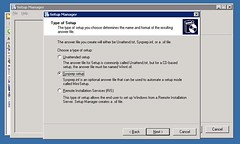
- Select the type of system you’re going to sysprep, and click “Next”
- Select “Yes, fully automate the installation” and click “Next”
- Now you need to fill in all the information required to complete the process:
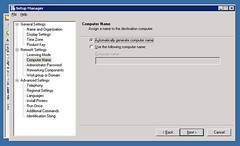
Once you complete the execution of the Setup Manager, it creates a new directory in the root of the system drive called sysprep. This directory contains all the information necessary for the Sysprep tool to execute.
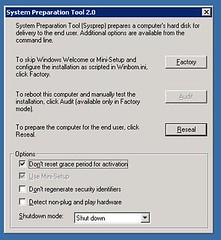
Now you need to execute the Sysprep tool, sysprep.exe:
In this tool:
- Click “OK” on the warning dialog that appears when running the tool.
- Select “Don’t reset grace period for activation”
- Set the “Shutdown mode” to “Shut down”
- Click on Reseal. That will leave the image ready for copying.
Once the image is copied, you can just configure a new virtual machine with the new image, and start it up. The last portion of the Windows setup process will execute:
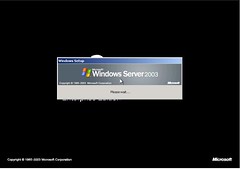
After a little while (<10min), the machine will reboot, and the process will be completed. You now have a brand new sysprep’d and cloned server up and running!!
I just had my first “issue” with Virtual Server 2005 R2. I was trying to create a virtual network with access to the outside world, but I couldn’t get the physical NICs to appear under the "Network adapter on physical computer:" option on the "Network Properties" screen. I could only get the “None (Guests Only) option, as shown here:
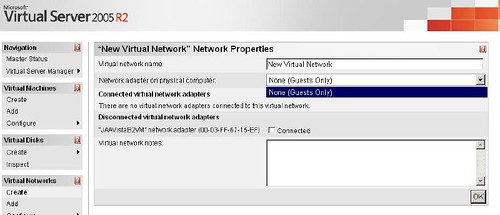
Now, before anyone says anything, I know that in order to have them appear here, I first need to enable the "Virtual Machine Networking Service" on the NICs that I want to share. The service, however, was not showing up on the network properties on the NIC connected to the network:
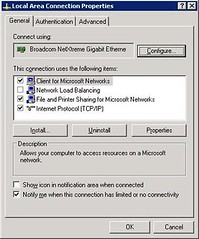
On the Virtual Server Event log, I was getting the following error logged:
"Virtual Server could not open its emulated Ethernet switch driver. To fix this problem, re-enable the Virtual Server Emulated Ethernet Switch service on one or more Ethernet adapters or reinstall Virtual Server."
Before going for the obvious, I first did a quick scan of the net for that log message and for the error in general, and the recommendation I found on several forums was to re-enable the service (not possible, wasn’t appearing), or to reinstall the server. Well, it turns out that the solution was VERY, VERY easy: just re-installing the service on the adapter did the trick. To do this, follow these steps:
- Open the network connection properties page
- Click on the “Install…” button
- Select the “Service” option under the “Select Network Component Type” window, and click “Add…”
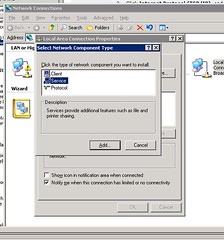
- Now you need to select the "Virtual Machine Networking Service" from the selection window:
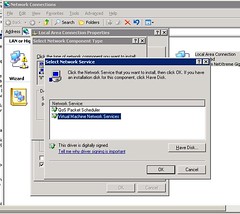
- In case you don’t see this service on the window, you need to reinstall it. To do this, click no “Have Disk…”, then “Browse…”, and browse to the Virtual Server Installation directory\Drivers and select either the x86 OR x64 directory (depending on your installation):
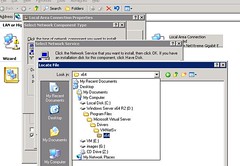
- Then select the file “VMNetSrv.inf” to install the server:
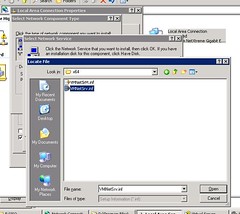
- The service should now show up under the Network Connection properties:
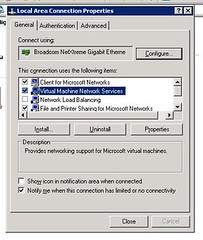
For some reason, the service is not installed on the adapters by deafult. With this process, however, the error messages go away, and you should be able to select the adapter on the “Network Properties" screen without having to re-install Virtual Server.
… On Virtual Server 2005 R2.
I installed FreeDOS in a new VM in about 5 minutes to test out the installation and the management tools.
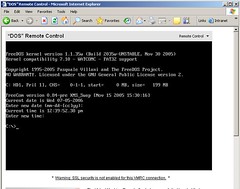
From now on, we are going to be working on several interesting projects related to virtualization, specifically to Virtual Server 2005 and the virtualization features coming up in Longhorn Server. I added a new category, Virtualization, where I’ll post any interesting bits of info I come accross. Make sure to check it out every once in a while. 